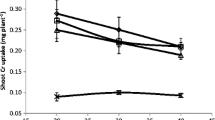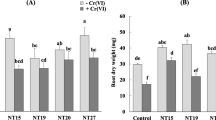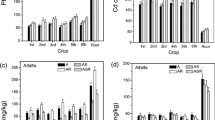Abstract
Pot culture experiments were performed under controlled greenhouse conditions to investigate whether four Cr(VI)-reducing bacterial strains (SUCR44, SUCR140, SUCR186, and SUCR188) were able to decrease Cr toxicity to Pisum sativum plants in artificially Cr(VI)-contaminated soil. The effect of pretreatment of soil with chromate-reducing bacteria on plant growth, chromate uptake, bioaccumulation, nodulation, and population of Rhizobium was found to be directly influenced by the time interval between bacterial treatment and seed sowing. Pretreatment of soil with SUCR140 (Microbacterium sp.) 15 days before sowing (T+15) showed a maximum increase in growth and biomass in terms of root length (93 %), plant height (94 %), dry root biomass (99 %), and dry shoot biomass (99 %). Coinoculation of Rhizobium with SUCR140 further improved the aforementioned parameter. Compared with the control, coinoculation of SUCR140+R showed a 117, 116, 136, and 128 % increase, respectively, in root length, plant height, dry root biomass, and dry shoot biomass. The bioavailability of Cr(VI) decreased significantly in soil (61 %) and in uptake (36 %) in SUCR140-treated plants; the effects of Rhizobium, however, either alone or in the presence of SUCR140, were not significant. The populations of Rhizobium (126 %) in soil and nodulation (146 %) in P. sativum improved in the presence of SUCR140 resulting in greater nitrogen (54 %) concentration in the plants. This study shows the usefulness of efficient Cr(VI)-reducing bacterial strain SUCR140 in improving yields probably through decreased Cr toxicity and improved symbiotic relationship of the plants with Rhizobium. Further decrease in the translocation of Cr(VI) through improved nodulation by Rhizobium in the presence of efficient Cr-reducing bacterial strains could also decrease the accumulation of Cr in shoots.






Similar content being viewed by others
References
Ackerley DF, Barak Y, Lynch SV, Curtin J, Matin A (2006) Effect of chromate stress on Escherichia coli K-12. J Bacteriol 188:3371–3381
Asmatullah Qureshi SN, Shakoori AR (1998) Hexavalent chromium induced congenital abnormalities in chick embryos. J Appl Toxicol 18(3):167–171
Bagchi D, Stohs SJ, Downs BW, Bagchi M, Preuss HG (2002) Cytotoxicity and oxidative mechanism of different forms of chromium. Toxicology 180:5–22
Becana M, Klucas RV (1992) Transtion metal in legume root nodules: iron dependent free radical production increases during nodules senescence. Proc Natl Acad Sci USA 89:8958–8962
Burd GI, Dixon DG, Glick BR (2000) Plant growth promoting bacteria that decreases heavy metal toxicity in plants. Can J Microbiol 46:237–245
Castro RO, Trujillo MM, Bucio JL, Cervantes C, Dubrovsky J (2007) Effects of dichromate on growth and root system architecture of Arabidopsis thaliana seedlings. Plant Sci 172:684–691
Cheung KH, Gu JD (2007) Mechanism of hexavalent chromium detoxification by microorganisms and bioremediation application potential: a review. Int Biodeterior Biodegrad 59:8–15
Chidambaram A, Sundaramoorthy P, Murugan A, Sankar Ganesh K, Baskaran L (2009) Chromium induced cytotoxicity in blackgram (Vigna mungo L.). Iran J Environ Health Sci Eng 6:17–22
Codd R, Irwin JA, Lay PA (2003) Sialoglycoprotein and carbohydrate complexes in chromium toxicity. Curr Opin Chem Biol 17(2):213–219
Desai C, Jain K, Madamwar D (2008) Evaluation of in vitro Cr(VI) reduction potential in cytosolic extracts of three indigenous Bacillus sp. isolated from Cr(VI) polluted industrial landfill. Bioresour Technol 99:6059–6069
Dixit V, Pandey V, Shyam R (2002) Chromium ions inactivate electron transport and enhance superoxide generation in vivo in pea (Pisum sativum L.cv. Azad) root mitochondria. Plant Cell Environ 25:687–690
Gheju M, Balcu I, Ciopec M (2009) Analysis of hexavalent chromium uptake by plants in polluted soils. Ovidius Univ Ann Chem 20:12–131
Ghosh M, Singh SPA (2005) A comparative study of cadmium phytoextraction by accumulator and weed species. Environ Pollut 133:365–371
Glick BR, Patten CL, Holguin G, Penrose GM (1999) Biochemical and genetic mechanisms used by plant growth promoting bacteria. Imperial College Press, London
Hayat S, Gulshan Khalique G, Irfan M, Wani AS, Tripathi BN, Ahmad A (2012) Physiological changes induced by chromium stress in plants: an overview. Protoplasma 249(3):599–611
Henson TM, Cory W, Rutter MT (2013) Extensive variation in cadmium tolerance and accumulation among populations of Chamaecrista fasciculate. PLoS ONE 8(5):e63200
Jackson ML (1973) Soil chemical analysis (Indian ed). Prentice Hall of India Pvt Ltd, New Delhi
Jayakumar K, Jaleel CA (2009) Uptake and accumulation of cobalt in plants: a study based on exogenous cobalt in soybean. Bot Res Int 2(4):310–314
Kalra A, Chandra M, Awasthi A, Singh AK, Khanuja SPS (2010) Natural compound enhancing growth and survival of rhizobial inoculants in vermicompost based formulation. Biol Fertil Soil 46:521–524
Khan MS, Zaidi A (2007) Synergistic effects of the inoculation with plant growth promoting rhizobacteria and an arbuscular mycorrhizal fungus on the performance of wheat. Turk J Agric For 31:355–362
Kožuh N, Štupar J, Gorenc B (2000) Reduction and oxidation process of chromium in soils. Environ Sci Technol 34:112–119
Krishna RK, Philip L (2005) Bioremediation of Cr(VI) in contaminated soils. J Hazard Mater 121:109–117
Liu DH, Jaing WS, Li MX (1993) Effect of chromium on root growth and cell division of Allium cepa. Isr J Plant Sci 42:235–243
Losi ME, Frankenberger WT (1994) Chromium-resistant microorganisms isolated from evaporation ponds of a metal processing plant. Water Air Soil Pollut 74:405–413
Mabbett AN, Macaskie LE (2001) A novel isolate of Desulfovibrio sp. with enhanced ability to reduce Cr(VI). Biotechnol Lett 23:683–687
Mamaril JC, Paner ET, Alpante BM (1997) Biosorption and desorption studies of chromium (iii) by free and immobilized Rhizobium (BJVr 12) cell biomass. Biodegradation 8:275–285
Mandiwana KL, Panichev N, Kataeva M, Siebert S (2007) The solubility of Cr(III) and Cr(VI) compounds in soil and their availability to plants. J Hazard Mater 147:540–545
Mishra S, Singh V, Srivastava S, Srivastava R, Srivastava MM, Dass S et al (1995) Studies on uptake of trivalent and hexavalent chromium by maize (Zea mays). Food Chem Toxicol 33:393–397
Mohanty M, Patra HK (2011) Attenuation of chromium toxicity by bioremediation technology. Environ Contam Toxicol 210:1–34
Moya JL, Ros R, Picazo I (1995) Heavy-metal hormone interactions in rice plants: effects on growth, net photosynthesis, and carbohydrate distribution. J Plant Growth Regul 14:61–67
Papassiopi N, Kontoyianni A, Vaxevanidou K, Xenidis A (2009) Assessment of chromium biostabilization in contaminated soils using standard leaching and sequential extraction techniques. Sci Total Environ 407:925–936
Patra RC, Malik B, Beer M, Megharaj M, Naidu R (2010) Molecular characterization of chromium (VI) reducing potential in Gram positive bacteria isolated from contaminated sites. Soil Biol Biochem 42:1857–1863
Polti MA, García RO, Amoroso MJ, Abate CM (2009) Bioremediation of chromium(VI) contaminated soil by Streptomyces sp. MC1. J Basic Microbiol 49:285–292
Polti MA, Atjiána MC, Amorosoa MJ, Abatea CM (2011) Soil chromium bioremediation: synergic activity of actinobacteria and plants. Int Biodeterior Biodegrad 65:1175–1181
Puzon GJ, Petersen JN, Roberts AG, Kramer DM, Xun L (2002) A bacterial flavin reductase system reduces chromates(III)–NAD+complex. Biochem Biophys Res 294(1):76–81
Rajkumar M, Freitas H (2008) Influence of metal resistant-plant growth-promoting bacteria on the growth of Ricinus communis in soil contaminated with heavy metals. Chemosphere 71:834–842
Rajkumar M, Nagendran R, Lee KJ, Lee WH (2005) Characterization of a novel Cr6+ reducing Pseudomonas sp. with plant growth-promoting potential. Curr Microbiol 50:266–271
Rajkumar M, Nagendran R, Lee KJ, Lee WH, Kim SZ (2006) Influence of plant growth promoting bacteria and Cr6+ on the growth of Indian mustard. Chemosphere 62:741–748
Rtidel H, Terytze K (1999) Determination of extractable chromium(VI) in soil using a photometric method. Chemosphere 39(4):697–708
Salunkhe PB, Dhakephalkar PK, Paknikar KM (1998) Bioremediation of hexavalent chromium in soil microcosms. Biotechnol Lett 20:749–751
Shanker AK, Cervantes C, Loza-Tavera H, Avudainayagam S (2005) Chromium toxicity in plants. Environ Int 31:735–753
Singh R, Divya S, Awasthi A, Kalra A (2012a) Technology for efficient and successful delivery of vermicompost colonized bioinoculants in Pogostemon cablin (patchouli) Benth. World J Microbiol Biotechnol 28:323–333
Singh R, Soni SK, Awasthi A, Kalra A (2012b) Evaluation of vermicompost doses for management of root-rot disease complex in Coleus forskohlii under organic field conditions. Aust Plant Pathol 41(4):397–403
Singh R, Singh R, Soni SK, Singh SP, Chauhan UK, Kalra A (2013a) Vermicompost from biodegraded distillation waste improves soil properties and essential oil yield of Pogostemon cablin (patchouli) Benth. Appl Soil Ecol 70:48–56
Singh R, Soni SK, Patel RP, Kalra A (2013b) Technology for improving essential oil yield of Ocimum basilicum L. (sweet basil) by application of bioinoculant colonized seeds under organic field conditions. Ind Crops Prod 45:335–342
Soni SK, Singh R, Awasthi A, Kalra A (2013a) A Cr(VI)-reducing Microbacterium sp. strain SUCR140 enhances growth and yield of Zea mays in Cr(VI) amended soil through reduced chromium toxicity and improves colonization of arbuscular mycorrhizal fungi. Environ Sci Pollut Res 21(3):1971–1979
Soni SK, Singh R, Awasthi A, Singh M, Kalra A (2013b) In vitro Cr(VI) reduction by cell-free extracts of chromate-reducing bacteria isolated from tannery effluent irrigated soil. Environ Sci Pollut Res 20(3):1661–1674
Subba Rao NS (1977) Soil microorganisms and plant growth. Oxford and IBH Publishing, New Delhi
Tappero R, Peltier E, Grafe M, Heidel K, Ginder-Vogel M, Livi KJT et al (2007) Hyperaccumulator Alyssum murale relies on a different metal storage mechanism for cobalt than for nickel. New Phytol 175:641–654
Wani PA, Khan MS (2010) Bacillus species enhance growth parameters of chickpea (Cicer arietinum L.) in chromium stressed soils. Food Chem Toxicol 48:3262–3267
Wani PA, Khan MS, Zaidi A (2008) Chromium-reducing and plant-growth promoting Mesorhizobium improves chickpea growth in chromium-amended soil. Biotechnol Lett 30:159–163
Wani PA, Zaidi A, Khan MS (2009) Chromium reducing and plant growth promoting potential of Mesorhizobium species under chromium stress. Bioremed J 13:121–129
Wise SS, Elmore LW, Holt SE, Little JE, Antonucci PG, Bryant BH et al (2004) Telomerase mediated lifespan extension of human bronchial cells does not affect hexavalent chromium induced cytotoxicity or genotoxicity. Mol Cell Biochem 255(1–2):103–112
Woolhouse HW (1983) Toxicity and tolerance in the responses of plant metals. In: Lange OL, Nobel PS, Osmond CB et al (eds) Encyclopedia of plant physiology, vol 12 C. Springer, Berlin, pp 245–300
Zayed AM, Terry N (2003) Chromium in the environment: factors affecting biological remediation. Plant Soil 249:139–156
Acknowledgments
The authors thank the Director of CSIR-CIMAP, Lucknow, India, for providing necessary facilities and encouragement during the course of investigation as well as the Indian Council of Medical Research, New Delhi, India, for providing financial support to S.K.S.
Author information
Authors and Affiliations
Corresponding author
Rights and permissions
About this article
Cite this article
Soni, S.K., Singh, R., Singh, M. et al. Pretreatment of Cr(VI)-Amended Soil With Chromate-Reducing Rhizobacteria Decreases Plant Toxicity and Increases the Yield of Pisum sativum . Arch Environ Contam Toxicol 66, 616–627 (2014). https://doi.org/10.1007/s00244-014-0003-0
Received:
Accepted:
Published:
Issue Date:
DOI: https://doi.org/10.1007/s00244-014-0003-0




